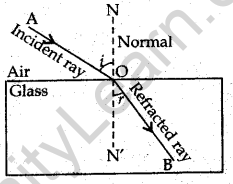Table of Contents
CBSE Previous Year Question Papers Class 10 Science SA2 Delhi 2014
Time allowed: 3 hours Maximum marks: 90
General Instructions:
- The Question Paper comprises two Sections, A and B. You are to attempt both the Sections.
- All questions are compulsory.
- There is no choice in any of the questions.
- All questions of Section-A and all questions of Section B are to be attempted separately.
- Question numbers 1 to 3 in Section A are one mark questions. These are to be answered in one word or in one sentence.
- Question numbers 4 to 6 in Section A are two marks questions. These are to be answered in about 30 words each.
- Question numbers 7 to 18 in Section A are three marks questions. These are to be answered in about 56 words each.
- Question numbers 19 to 24 in Section A are five marks questions, these are to be answered in about 70 words each.
- Question numbers 25 to 33 in Section B are multiple choice questions based on practical skills. Each question is a one mark question. You are to select one most appropriate response out of the four provided to you.
- Question numbers 34 to 36 in Section B are two marks questions based on practical skills. These are to be answered in brief.
SET I
SECTION A
Question.1. Write the number of vertical columns in the modem periodic table. What are these columns called?
Answer. There are 18 vertical columns in a periodic table. These vertical columns are called groups.
Question.2. Give the respective scientific terms used for studying:
(i) the mechanism by which variations are created and inherited and (ii) the development of new type of organisms from the existing ones.
Answer. (i) Reproduction
(ii) Speciation
Question.3. Water is a valuable resource. List two ways that you would suggest every family member to save this resource.
Answer.
- Leakage of taps should be checked and repaired.
- Rinsed water of washed clothes can be reused for watering the plants or for cleaning the floor etc.
Question.4. List four advantages of vegetative propagation.
Answer. Four advantages of vegetative propagation.
- Plants grown by vegetative propagation grow much faster than those grown from seeds.
- A large number of plants can be produced by the method of vegetative propagation.
- The plants grown by vegetative propagation usually need less attention in their early years than the plants grown from seeds.
- Seedless plants can also be grown from this method.
Question.5. Draw a ray diagram to show the path of the reflected ray corresponding to an incident ray which is directed towards the principal focus of a convex mirror. Mark on it the angle of incidence and the angle of reflection.
Answer.

Question.6. Why is Government of India imposing a ban on the use of polythene bags? Suggest two alternatives to these bags and explain how this ban is likely to improve the environment.
Answer. Plastic bags are non-biodegradable which can not be broken down into non-poisonous substances in nature.
Plastic bags are the main cause of sewer blockages as plastic bags are not decomposed by micro-organisms.
Plastic bags if eaten by stray animals (like cows) can block their alimentary canal.
Two alternatives:
- We should take our own jute or cloth bags while going for purchasing articles from the market.
- Disposable paper cups should be used for serving tea in trains instead of plastic cups.
- Shopkeepers can use paper bags instead of plastic bags.
Question.7. State the meaning of functional group in a carbon compound. Write the functional group present in (i) ethanol and (ii) ethanoic acid and also draw their structures.
Answer. An ‘atom’ or ‘a group of atoms’ which makes a carbon compound reactive and decides its properties (or functions) is called a functional group. .
(i) Ethanol —> Alcohol group (—OH)
(ii) Ethanoic acid —> carboxylic acid group (—COOH)

Question.8. Write the name and general formula of a chain of hydrocarbons in which an addition reaction with hydrogen can take place. Stating the essential conditions required for an addition reaction to occur write the chemical equation giving the name of the reactant and the product of such a reaction.
Answer. Addition reactions are a characteristic property of unsaturated hydrocarbons, i.e., Alkenes and Alkynes.
General formula of—Alkene: CnH2n, Alkyne: CnH2n-2
For example, Ethene undergoes addition reaction with hydrogen when heated in the presence of nickel catalyst to form ethane saturated hydrocarbon.

Thus addition of hydrogen to an unsaturated hydrocarbon gives a saturated hydrocarbon. This reaction is known as hydrogenation.
Question.9. Based on the group valency of elements state the formula for the following giving justification for each:
(i) Oxides of 1st group elements,
(ii) Halides of the elements of group 13, and
(iii) Compounds formed when an element of group 2 combines with an element of group 16.
Answer.
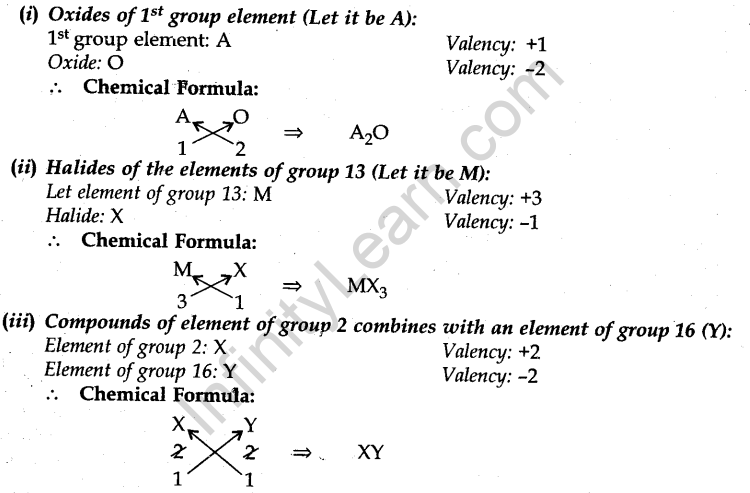
Question.10. (a) Define the following terms:
(i) Valency; (ii) Atomic size
(b) How do the valency and the atomic size of the elements vary while going from left to right along a period in the modem periodic table?
Answer. (a) (i) Valency. The combining capacity of an element is called its valency.
• The valency of an element is determined by the number of valence electrons present in the atom of the element.
• The number of electrons lost or gained or shared by one atom of an element to achieve the nearest inert gas configuration gives the valency of the element.
(ii)Atomic size. The atomic size of an atom is the distance between the centre of the nucleus and outermost electron shell of an isolated atom.
(b) -On moving from left to right along a period in the modem periodic table, the valency of elements increases from 1 to 4 and then decreases to zero.
-On moving from left to right in a period of the periodic table, the size of the atoms decreases.
Question.11. Draw diagrams to explain the regeneration that takes place in each of the body parts of planaria when its body is cut into three pieces. Name any other organism in which a similar process can be observed.
Answer. The process of getting back a full organism from its body parts is called regeneration. The simple animals like hydra and planaria show regeneration.
Diagram for regeneration in planaria. See Q. 24(b), 2011 (I Delhi).
Question.12. List any four methods of contraception used by humans. How does their use have a direct effect on the health and prosperity of a family?
Answer. There are three different methods of contraception:
- Barrier methods. In these methods, physical devices such as condoms, diaphragm and cervical caps are used. These devices prevent the entry of sperm in the female genital tract, thus acting as a barrier between them.
- Surgical methods. There are surgeries that can be carried out in males and females. In males, a small portion of the sperm duct (vas deferens) is blocked by surgical operation. It prevents the egg to reach the uterus. In both the cases, fertilisation will not take place.
- Chemical methods. This category of contraceptive acts by changing the hormonal balance of the body so that eggs are not released and fertilisation cannot occur. Females use two types of pills for preventing pregnancies, i.e., oral pills and vaginal pills. The oral pills contain hormones which stop the ovaries from releasing ovum into the fallopian tube. This is also called oral contraceptives (OC).
- Other contraceptive devices such as loop or the copper-T are placed in the uterus to . prevent pregnancy.
Effect on health and prosperity of a family:
- Contraceptive methods are used to prevent the spreading of sexually transmitted diseases like syphilis, AIDS, etc.
- Contraceptive methods are also used to control human population by checking the unwanted pregnancies during sexual activities.
- It helps in family planning by controlling the number of children in the family, thereby reducing the chances of financial burden and poverty.
Question.13. (a) Give the evidence that the birds have evolved from reptiles.
(b) Insects, octopus, planaria and vertebrates possess eyes. Can we group these animals together on the basis of eyes that they possess? Justify your answer giving reason.
Answer. (a) A fossil bird called Archaeopteryx looks like a bird but it has many features which are found in reptiles. Archaeopteryx has feathered wings like birds but teeth and tail like those of reptiles. Therefore Archaeopteryx is a connecting link between the reptiles and birds and hence suggests that the birds have evolved from the reptiles.
(b) Insects, octopus, planaria and vertebrates posses eyes but these animals can not be put together on the basis of eyes because the structure of eyes in each of. there ‘ organisms is different which suggests their separate evolutionary origins. Thus all
these animals are put in different groups.
Question.14. A cross was made between pure breeding pea plants, one with round and green seeds and the other with wrinkled and yellow seeds.
(a) Write the phenotype of F1 progeny. Give reason for your answer.
(b) Write the different types of F2 progeny obtained along with their ratio when F1 progeny was selfed.
Answer. (a) The cross was made between round, green seeds and wrinkled, yellow seeds. In the given cross, were taken into account, which is a dihybrid cross.
Yellow colour and round shape is dominant over green colour and wrinkled shape.
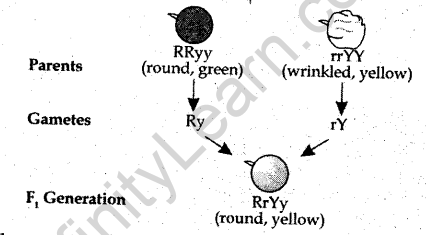
The above cross shows round and yellow seeds in generation. It occurs because dominant traits (round and yellow) express themselves, whereas recessive traits (wrinkled and green) get suppressed.

Question.15. A spherical mirror produces an image of magnification -1 on a screen placed at a distance of 50 cm from the mirror.
(a) Write the type of mirror.
(b) Find the distance of the image from the object.
(c) What is the focal length of the mirror?
(d) Draw the ray diagram to show the image formation in this case.
Answer.
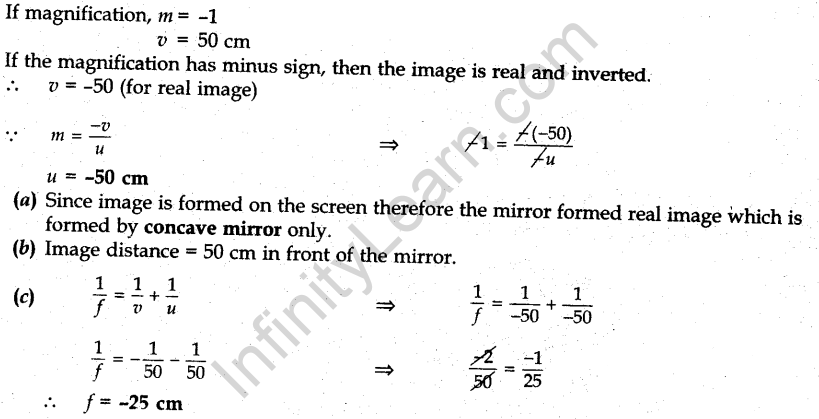

Question.16. State the laws of refraction of light. If the speed of light in vacuum is 3 x 108 ms-1, find the speed of light in a medium of absolute refractive index 1.5.
Answer. Laws of refraction of light:
- The incident, the refracted ray and the normal at the point of incidence, all lie in the same plane.
- The second law of refraction is called Snell’s law of refraction. According to Snell’s law, “The ratio of sine of angle of incidence to the sine of angle of refraction is a constant for a given pair of mediums”.


Question.17. Explain giving reason why the sky appears blue to an observer from the surface of the earth? What will the colour of the sky be for an astronaut staying in the international space station orbiting the earth? Justify your answer giving reason.
Answer. Sky appears blue. The molecules of air and other fine particles in the atmosphere have a size smaller than the wavelength of visible light. So these particles scatter more effectively the light rays of shorter wavelength at the blue end than light of longer wavelengths at the red end. When the scattered blue light enters our eyes, it gives us the feeling of a blue sky.
Colour of sky to an astronaut. There, is no atmosphere containing air in space to scatter sunlight. As there is no scattering of light in space, the scattered light does not reach the eyes and the sky appears dark instead of blue to an astronaut in outer space.
Question.18. Our food grains such as wheat and rice, the vegetables and fruits and even meat are found to contain varying amounts of pesticide residues.” State the reason to explain how and why it happens?
Answer. Pesticides are poisonous chemical substances which are sprayed over crop plants to protect them from pests and diseases. These pesticides mix up with soil and water and are then absorbed by growing plants along with water and other minerals.. Thus pesticides enter the food chain at the producer level (plant level) and in the process s of transfer of food through food chains these harmful chemicals get concentrated at each trophic level. These chemicals are non-biodegradable, so they get accumulated at each trophic level. Pesticides present in wheat grains, fruits vegetables and meat cannot always be removed by washing, etc.
Question.19. State the reason why carbon can neither form C4+ cations nor C4- anions, but forms covalent compounds. Also state reasons to explain why covalent compounds:
(a) are bad conductors of electricity?
(b) have low melting and boiling points?
Answer. Carbon atoms have 4 electrons in their outermost shell. So needs to gain or lose electrons to attain noble gas configuration.
— It could gain four electrons forming C4- anion. But it would be difficult for the nucleus with six protons to hold on to ten electrons.
— It could lose four electrons forming C4+ cation. But it would require a large amount energy to remove four electrons from its outermost shell.
Because of these reasons, carbon shares its valence electrons to complete its octet with other atoms to form covalent bonds.
(a) Covalent compounds are bad conductors of electricity because they do not contain ions.
(b) Covalent compounds have usually low melting and boiling points because they are made up of electronically neutral molecules. So the force of attraction between the molecules of a covalent compound is very weak. Only a small amount of heat energy is required to break these weak molecular forces, due to which covalent compounds have low melting and boiling points.
Question.20. (a) Give one example each of a unisexual and a bisexual flower.
(b) Mention the changes a flower undergoes after fertilisation.
(c) How does the amount of DNA remain constant though each new generation is a
combination of DNA copies of two individuals?
Answer. (a) Unisexual Flower — Papaya Bisexual Flower — Hibiscus
(b) After fertilisation, the fertilised egg divides several times to form an embryo within the ovule. The ovule, develops a tough coat around it and is gradually converted into a seed (containing the baby plant along with food). The ovary of flower develops and becomes a fruit (with seeds inside it). The other parts of flower like sepals, petals, stamens, stigma and style dry up and fall off. Only the vary is left behind.
(c) In sexual reproduction, though the genetic material DNA from two gametes, male and female gametes, combine together to form a new cell ‘zygote’ but the amount of DNA in zygote does not get doubled. This is because the gametes are special type of cells which contain only half the amount of DNA as compared to the normal body cells of an organism. So the new cell zygote formed by two gametes cells will have the normal amount of DNA.
Question.21. (a) Name the respective part of human female reproductive system:
(i) that produces eggs.
(ii) where fusion of egg and sperm takes place, and
(iii) where zygote get implanted.
(b) Describe in brief what happens to the zygote after it gets implanted.
Answer. (a) Part of human female reproductive system:
(i) that produces eggs—Ovary
(ii) where fusion of egg and sperm takes place—Fallopian tube
(iii) where zygote get implanted—Uterus
(b) After zygote gets implanted, a disc like special tissue develops between the uterus wall and embryo (foetus) which is called placenta. The foetus is connected to the placenta in the mother’s body through the umbilical cord. The exchange of nutrients, oxygen and waste products between the embryo and the mother takes place through the placenta.
Question.22. A student wants to project the image of a candle flame on the walls of school laboratory by using a lens:
(a) Which type of lens should he use and why?
(b) At what distance in terms of focal length ‘F’ of the lens should he place the candle flame so as to get (i) a magnified, and (ii) a diminished image respectively ou the wall?
(c) Draw ray diagram to show the formation of the image in each case.
Answer. (a) A convex lens should be used. This is because it can produce a real image of the
candle flame on the wall as it is a converging lens where refracted rays actually meet. (b) & (c) (i) A real magnified image is formed when the candle flame is placed between F and 2F from the convex lens on the other side of the wall.

(ii) A real diminished image is formed when the candle flame is placed beyond 2F from the convex lens on the other side of the wall.

Question.23. (a) List three common Refractive defects of vision. Suggest the way of correcting these defects.
(b) About 45 lac people in the developing countries are suffering from corneal blindness. About 30 lac children below the age of 12 years suffering from this defect can be cured by replacing the defective cornea with the cornea of a donated eye. How and why can students of your age involve themselves to create awareness about this fact among people?
Answer. (a) The three defects of vision:
1. Myopia. Myopia is the defect of the eye vision due to which a person can see the near objects clearly, but he can not see the far objects clearly.
Causes of myopia. Myopia is caused due to the elongation of the eye ball and due to decrease in the focal length of the eye lens. The eye lens becomes more convergent. Myopia can be corrected by using a concave lens of suitable focal length in the spectacles of such a person.
Diagram. See Q. 17, 2011 (I Outside Delhi).
2. Long-sightedness or hypermetropia. Due to this defect, a person is not able to see the nearby objects clearly but can see the distant objects clearly.
Causes of hypermetropia. It is caused due to the following reasons:
(i) Normal increase in the focal length of the eye lens. The lens becomes less convergent.
(ii) Shortening of the eyeball size.
Correction. Long sightedness can be corrected by using a convex lens of suitable focal length in the spectacles of such a person.
When a convex lens of suitable power is placed in front of the hypermetropic eye then the diverging rays of light coming from the nearby object are first converged by this convex lens. Due to this, the convex lens forms a virtual image of the nearby object at a point near to the hypermetropic eve. Then the hypermetropic eye can easily focus the image formed by convex lens on the retina.
Diagram. See Q. 17, 2011 (I Delhi).
3. Presbyopia. The power of accommodation of the eye decreases with ageing. It occurs due to the gradual weakening of the ciliary muscles and decreasing flexibility of the crystalline lens. The near point of the eye increases with age. It may reach even 2 metres. This defect is called presbyopia.
Causes of presbyopia. It is mainly caused due to the weakening of the ciliary muscles of the eyes. Such a person may suffer from myopia and hypermetropia. This defect is then corrected by using bifocal lenses of suitable focal lengths. The upper part of the lens is a concave lens for correcting myopia to see the distant objects clearly, while the lower part of the lens has a convex lens to correct the hypermetropia to see the nearby objects clearly.
(b) We have seen advertisements in media persuading people for eye donation. If cornea of the eyes are removed within 6 hours of the death of a person, it can be transplanted to a person suffering from corneal blindness. There are more than 45 lakh cases of corneal blindness and unfortunately out of these a major portion is that of children aged below 12 years. If a person comes forward for eye donation, he can save two corneal blind persons by donating one eye to each.
How exciting it feels to think that after one’s death, he/she can make two blind persons see this wonderful world! Therefore it is a must to promote such advertisements to encourage people and make them aware of this noble cause.
Question.24. The position of three elements A, B and C in the Periodic Table are shown below:

Giving reasons, explain the following:
(a) Element A is a non-metal.
(b) Atom of element C has a larger size than atom of element A.
(c) Element B has a valency of 1.
Answer. (a) Element A is a non-metal because it belongs to Group VII therefore it has 7 electrons
in its outermost shell. It needs one electron to acquire nearest inert gas configuration ’ and form a monovalent -ve ion.
(b) Atom of element C has a larger size than that of element A because C belongs to the 3rd period therefore it has three shells whereas A belongs to the 2nd period thus it has two shells.
(c) Element B has a valency of 1 because it belongs to Group I and has one valence electron. To complete its outermost shell or to acquire nearest noble gas configuration it loses one electron and forms a monovalent + ve ion.
SECTION B
Question.25. Why you add about 2 mL of acetic acid to a test tube containing an equal amount of distilled water and leave the test tube to settle after shaking its contents, then after about 5 minutes what will you observe in the test tube:
(A) A white precipitate settling at its bottom,
(B) A clear colour less solution,
(C) A layer of water over the layer of acetic acid, or
(D) A layer of acetic acid over the layer of water.
Answer. (B)
Question.26. In order to study saponification reaction we first prepare 20% solution of sodium hydroxide. If we record the temperature of this solution just after adding sodium hydroxide flakes to water and also test its nature using litmus, it may be concluded that the process of making this solution is:
(A) exothermic and the solution is alkaline.
(B) endothermic and the solution is alkaline.
(C) endothermic and the solution is acidic.
(D) exothermic and the solution is acidic.
Answer. (A)
Question.27. While studying saponification reaction for the preparation of soap, the teacher suggested to a student to add a small quantity of common salt to the reaction mixture. The function of common salt in this reaction is to:
(A) reduce the alkalinity of the soap.
(B) reduce the acidity of the soap.
(C) enhance the cleansing capacity of soap, or
(D) favour precipitation of soap.
Answer. (D)
Question.28. A student has obtained the image of a distant object with a concave mirror to determine its focal length. If he has selected a well illuminated red building as object, which of the following correctly describes the features of the image formed?
(A) Virtual, inverted, diminished image in red shade
(B) Real, erect, diminished image in pink shade
(C) Real, inverted, ^diminished image in red shade
(D) Virtual, erect, enlarged image in red shade
Answer. (C)
Question.29. A student obtained an image of a distant object on a screen to determine the focal length F1 of the given lens. His teacher after checking the image, gave him another lens of focal length F2 and asked to focus the same object on the same screen. The student ‘ found that to obtain a sharp image he has to move the lens away from the screen. From this finding we may conclude that both the lenses given to the student were:
(A) Concave and F1 < F2
(B) Convex and F1 < F2
(C) Convex and F1> F2
(D) Concave and F1 >F2
Answer. (B)
Question.30. Which one of tire following pairs of vegetables is an example of homologous structures:
(A) Potato and sweet potato
(B) Carrot and radish
(C) Carrot and tomato
(D) Tomato and radish
Answer. (B)
Question.31. Study the following diagrams showing various stages of binary fission in Amoeba:
The correct sequence is:

(A) I, IV, III, II, V (B) I, III, IV, II, V (C) I, II, IV, III, V (D) I, II, III, IV, V
Answer. (B)
Question.32. Identify the figures showing the process of budding in yeast.

(A) I, II and III (B) II, III and IV (C) I, II and IV (D) III, IV and I ,IV
Answer. (C)
Question.33. Study the following four experimental set-ups I, II, III and IV for the experiment, “To trace the path of a ray of light through a rectangular glass slab”.
Which of the marked set-ups is likely to give best results (P1 and P2 are the positions of pins fixed on the incident ray)?

(A) I (B) II (C) III (D) IV
Answer. (D)
Question.34. What do you observe when dil. HCl is added on Zn pieces taken in a test tube? How would you identify the gas evolved? Write one use of this gas.
Answer. Observation. A colourless gas is evolved with brisk bubbles from the test tube.
When a burning match stick is brought near the gas, then the gas bums with a pop sound. The gas evolved is H2 gas. H2 gas is used as fuel in the space crafts.
Question.35. What do you observe on seeing the glides showing reproduction in amoeba? What is the name given to this method of reproduction in Amoeba?
Answer. On observing this slide, we see different stages under which the nucleus of amoeba cell is dividing into two parts. Method of reproduction in amoeba. Binary fission
Question.36. For finding the focal length of a concave mirror, where do we keep the object? What is the position of image formed? On which structure we get the image? What is the nature of the image formed?
Answer. A large sized object placed at a far off (Infinity) place, seen from the window of the lab, is taken as object.
The image is formed at F point of the mirror. This image is formed on the screen.
The distance between the mirror and the screen is measured; which is equal to focal length of the mirror. The image formed is real and inverted.
SET II
Except for the following questions, all the remaining questions have been asked in Set-I.
SECTION A
Question.1. Write the number of horizontal rows in the modern periodic table. What are these rows called?
Answer. The horizontal rows of elements in a modem periodic table are called periods. There are seven periods in the modem periodic table.
Question.2. Name the information source for making proteins in the cells.
Answer. DNA—(Deoxyribo Nucleic Acid) is the information source for making proteins in the cells.
Question.3. List two measures that you would suggest for the better management of water resources.
Answer.
- Rainwater harvesting—it means rain water should not be allowed flow into the drains but make it percolate into the soil more efficiently.
- Recycling of water used in bathrooms and kitchens should be encouraged.
- Construction of dams.
Question.4. List four modes of asexual reproduction.
Answer. Four mode of asexual reproduction:
- Binary fission
- Budding
- Spore formation
- Regeneration
Question.5. Draw a ray diagram to show the path of the reflected ray corresponding to an incident ray which is directed parallel to the principal axis of a convex mirror. Mark on it the angle of reflection.
Answer. Ray diagram. See Q. 5, 2014 (I Delhi).
Question.7. Consider two elements ‘A’ (Atomic number 17) and ‘B’ (Atomic number 19):
(i) Write the positions of these elements in the modem periodic table giving justification.
(ii) Write the formula of the compound formed when ‘A’ combines with ‘B’.
(iii) Draw the electron dot structure of the compound and state the nature of the bond formed between the two elements.
Answer. (i) Element ‘A’:
Atomic number = 17 Electronic configuration = 2, 8, 7
‘A’ belongs to 17th group as it has ‘7 electrons in its outermost shell.
‘A’ belongs to 3rd period as it has three shells in its atom.
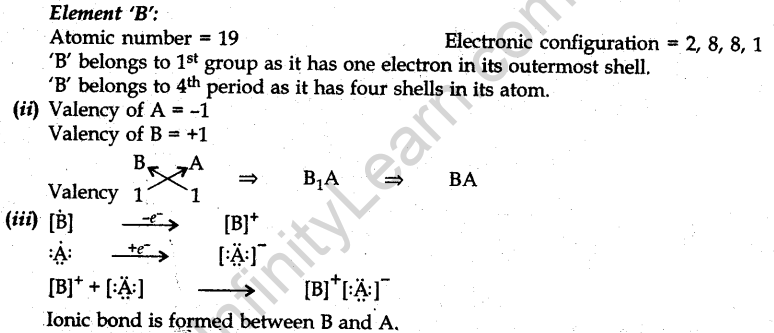
Question.10. (a) Write the names of those parts of a flower which serve the same function as the following do in the animals:
(i) testis (ii) sperm (iii) ovary (iv) egg
(b) State the function of flowers in the flowering plants.
Answer. (a) (i) testis — anther .
(ii) sperms — pollen grains
(iii) ovary — ovary –
(iv) egg — egg or ovum
(b) The function of flower in flowering plants is to assist in sexual reproduction, i.e., to make male and female gametes and to ensure that fertilisation will take place to make new seeds for the reproduction in plants.
Question.12. (a) Mendel Crossed tall pea plants with dwarf pea plants in his experiment. Write his observations giving seasons on the and F2 generations.
(b) List any two contrasting characters other than height that Mendel used in his experiments in pea plants.
Answer. (a) In Mendel’s experiments with pea plants, when he cross bred a tall pea plant with a dwarf pea plant, he found that the first generation F2 was of only tall plants. In the progeny, no dwarf plants were obtained. However in F2 generation, both tall and dwarf plants were obtained in the ratio of 3 : 2 respectively. In the F2 progeny both traits tallness and dwarfness were inherited where the tall character was the dominant trait and dwarf character was the recessive trait. .
Flow chart depicting Mendel’s experiment. See Q. 14, 2013 (I Outside Delhi).
(b) Contrasting characters of pea plant
— round and green seeds.
— wrinkled and yellow seeds.
Question.14. A spherical mirror produces an image of magnification -1 on a screen placed at a distance of 40 cm from the mirror: 3
(i) Write the type of mirror (ii) What is the nature of the image formed?
(iii) How far is the object located from the mirror?
(iv) Draw the ray diagram to show the image formation in this case.
Answer. • Spherical mirror • m = -1
• image is formed on a screen • image distance, v = 40 m
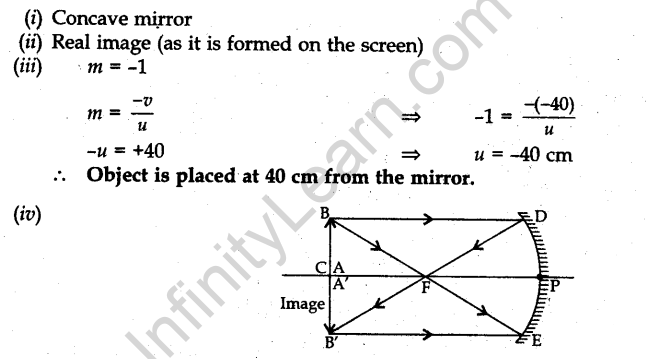
Question.15. Why does sun seem to rise two minutes before the actual sunrise and set two minutes after the actual sunset? Explain with the help of labelled diagram.
Answer. See Q. 4, 2011 (I Outside Delhi).
Question.17. State the meaning of the functional group in an organic compound. Write the formula of the functional group present in alcohols, aldehydes, ketones and carboxylic acids.
Answer. An ‘atom’ or ‘a group of atoms’ which makes a carbon compound reactive and decides its properties is called a functional group.

Question.24. A student wants to project the image of a candle flame on the walls of school laboratory by using a mirror.
(a) Which type of mirror should he use and why?
(b) At what distance in terms of focal length ‘f’ of the mirror should he place the candle flame so as to get the magnified image on the wall?
(c) Draw a ray diagram to show the formation of image in this case.
(d) Can he use this mirror to project a diminished image of the candle flame on the same wall? State ‘how’ if your answer is ‘yes’ and ‘why not’ if your answer is ‘no’.
Answer. (a) Concave mirror should be used as only this mirror will produce a real image (i.e, on the wall).
(b) The object should be placed between and ‘2/’ so as to get the magnified image on the wall.
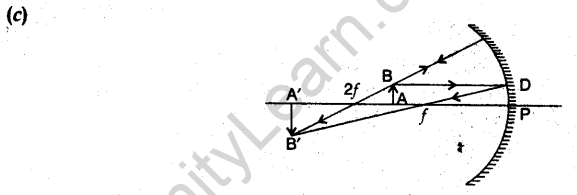
(d) When the candle flame is placed beyond 2f, A diminished real image will be formed on the wall.
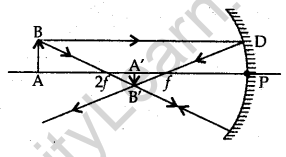
SET III
Except for the following questions, all the remaining questions have been asked in Set-I and Set-11.
SECTION A
Question.1. Write any one difference in the electronic configurations of group 1 and group 2 elements?
Answer.
- Elements of group 1 have one electron in their outermost shell.
- Elements of group 2 have two electrons in their outermost shell.
Question.2. Write the contribution of Charles Darwin in the field of ‘evolution’.
Answer. Charles Robert Darwin gave the theory of evolution in his famous book “The Origin of Species”.
- The theory of evolution proposed by Darwin is known as “The Theory of Natural Selection”.
- This theory suggests that the best adapted organisms are selected by nature to pass on their characteristics to the next generation.
Question.3. “We need to manage our resources.” List two reasons to justify this statement.
Answer. (i) The resources of the earth are limited.
(ii) The proper management can ensure equitable distribution of natural resources so that all the people can benefit from the development of these resources.
Question.6. List two environment friendly practices or habits which need to be followed by every member of a family/community. Explain how these practices will support the “Save the Environment” mission.
Answer. Two environment friendly practices to help save the environment are:
- Disposal of wastes after separating them into biodegradable and non-biodegradable waste material.
- Use of unleaded petrol and alternate sources of energy, keeping the car engines properly tuned and serviced and types inflated to the right pressure, so that the vehicle runs smoothly.
Question.7. Explain with help of a labelled diagram, the cause of twinkling of stars.
Answer. Twinkling of Stars. The twinkling of a star is due to atmospheric refraction of star light. The atmospheric refraction occurs in a medium of gradually changing refractive index. Since the atmosphere bends star light – towards the normal, the apparent position of the star is slightly different from the actual position. This apparent position of the star is not stationary, but keeps on changing slightly as the physical conditions of the earth’s atmosphere are not stationary.
Since the stars are very distant, they act as point-sized sources of light. As the path of rays of light coming from the star goes on varying slightly, the apparent position of the star fluctuates and the amount of light entering the eye flickers—the star sometimes appears brighter and at other times appears fainter, which is the twinkling effect.
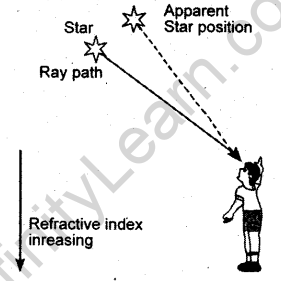
Question.10. A spherical mirror produces an image of magnification -1.0 on a screen placed at a distance of 30 cm from the pole of the mirror.
(i)Write the type of minor in this case.
(ii)What is the focal length of the mirror?
(iii)What is the nature of the image formed?
(iv)Draw the ray diagram to show the image formation in this case.
Answer.
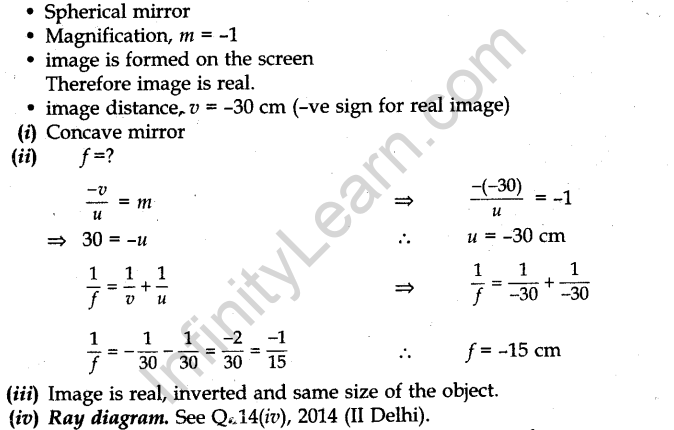
Question.11. What are esters? How are they prepared? List two uses of esters.
Answer. Esters are usually volatile liquids having pleasant smell (in fruity smell).
Preparation. When carboxylic acid reacts with an alcohol in the presence of a little concentrated sulphuric acid, it gives a pleasant smelling ester.
For example. When ethanoic acid is warmed with ethanol in the presence of a few drops of concentrated sulphuric acid, a sweet smelling ester called ethyl ethanoate is formed.

Uses:
- Esters are used in making perfumes.
- Esters are used in making artificial flavours and essences used in icecreams, sweets and cold drinks.
Question.15. On cutting the body of an organism into many pieces it was observed that many of these pieces developed as new individuals. Name the process and list two organisms in which this process may be observed. Draw a schematic diagram to illustrate the changes that are likely to be observed during the development of new individuals in any one of the organisms named.
Answer. Process is Regeneration.
Examples. The simple animals like hydra and planaria show regeneration.
Diagram. See Q. 24(b), 2011 (I Delhi).
Question.18. (a) Mendel in one of his experiments with pea plants crossed a variety having round seeds with one having wrinkled seeds. Write his observations, giving reasons, of F1 and F2 progeny.
(b) List any two contrasting characters other than roundness of pea plants that Mendel used in his experiments with pea plants.
Answer. (a) In Mendel’s experiment with pea plants, when he cross bred a round seed plant with a wrinkled seed plant, he found that the first generation (F1) was only round seed plants. In the F1 progeny, no wrinkled seed plants were obtained. However, in the F2 progeny both traits round seed and wrinkled seed were obtained in the ratio 3 : 1 respectively. The trait which is obtained in F1 generation is dominant trait, therefore round seed character was dominant.
Flow chart:
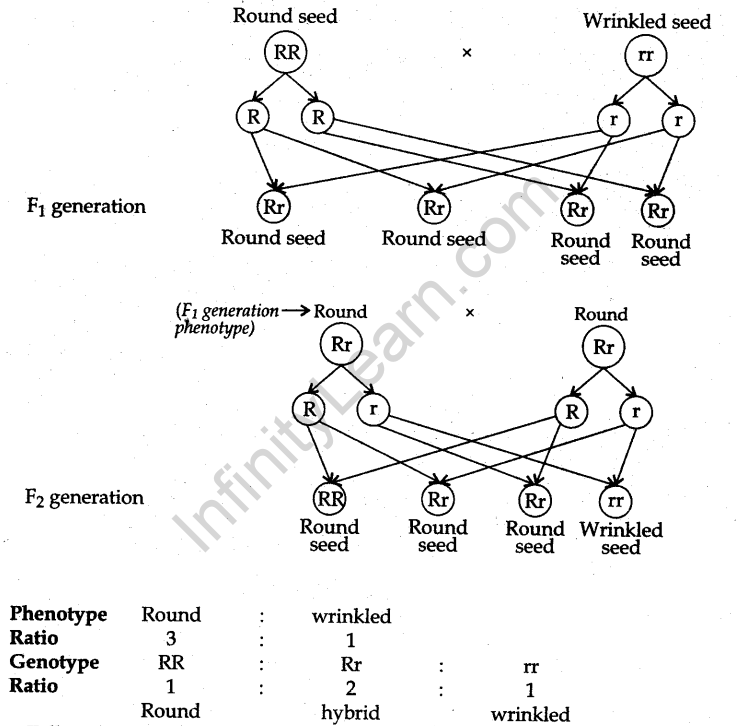
(b) • Tallness and dwarfness.
• Green seed and yellow seed. These are the two contrasting characters that Mendel used in his experiment with pea plants.
Question.24. (a) Write the name of the human male reproductive organ that produces sperms and secretes a hormone. Name the hormone secreted and state its function?
(b) Write the site of fertilization and the part where the zygote gets implanted in the human female.
(c) State, in brief, how an embryo gets its nourishment inside the mother’s body.
Answer. (a) Testes is the human male reproductive organ that produces sperms and secretes male
sex hormone—testosterone. The function of testosterone hormone is to control the development of male sex organs and male features such as deeper voice, moustache, beard and more body hair during male puberty.
(b) • Site of fertilisation: Fallopian Tube.
• Zygote gets implanted in uterus of human female.
(c) See Q. 13, 2013 (III Outside Delhi).



